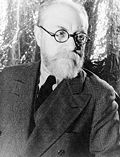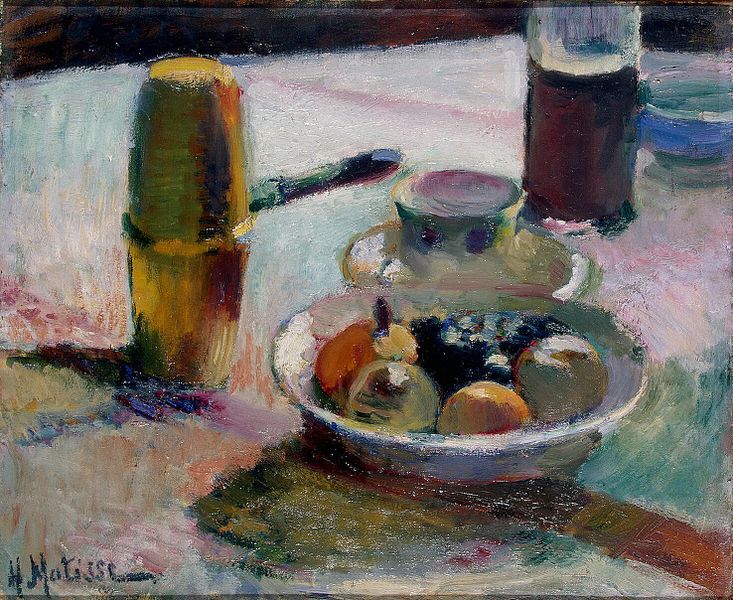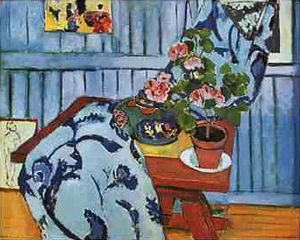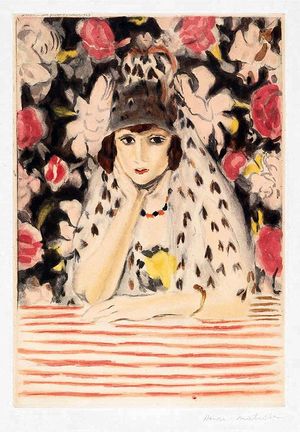Difference between revisions of "Henri Matisse"
| Line 1: | Line 1: | ||
[[Image:Henri Matisse 1933.jpg|right|120px]] | [[Image:Henri Matisse 1933.jpg|right|120px]] | ||
| − | '''Henri Matisse''' (Le Cateau-Cambresis 1869 - Nice 1954) French [[Fauvism|Fauvist]] [[painter]] and [[sculptor]]. | + | '''Henri Matisse''' (Le Cateau-Cambresis 1869 - Nice 1954) French [[Fauvism|Fauvist]] [[painter]] and [[sculptor]]. Matisse and [[Renoir]] were friends with a common bond; they loved color, beauty, and painting. [http://newlife.com/renoir-and-matisse] |
| − | Matisse made copies of many paintings in the [[Louvre]] to learn painting. He was more than just a Fauvist. He also experiment with other techniques like [[Cubism]] and [[Pointillism]]. | + | Matisse made copies of many paintings in the [[Louvre]] to learn painting. He was more than just a Fauvist. He also experiment with other techniques like [[Cubism]] and [[Pointillism]]. In his old age, he worked with painted paper and scissors, making collages. |
| − | In his old age, he worked with painted paper and scissors, making collages. | + | |
[[File:Henri Matisse The Window 1916.jpg|thumb|left|The Window, 1916.]] | [[File:Henri Matisse The Window 1916.jpg|thumb|left|The Window, 1916.]] | ||
| Line 12: | Line 11: | ||
<blockquote> | <blockquote> | ||
| − | The leader of the "Fauves" was Matisse, who had arrived at the ''Fauve'' style after earlier experimenting with the various Post-Impressionist styles of Van Gogh, Gauguin, and Cézanne, and the Neo-Impressionism of Seurat, Cross, and Signac. These influences inspired him to reject traditional three-dimensional space and seek instead a new picture space defined by the movement of color planes. [http://www.metmuseum.org/toah/hd/fauv/hd_fauv.htm] ''Fauvism'' began around 1900 and continued beyond 1910. | + | The leader of the "Fauves" was Matisse, who had arrived at the ''Fauve'' style after earlier experimenting with the various Post-Impressionist styles of Van Gogh, Gauguin, and Cézanne, and the Neo-Impressionism of Seurat, Cross, and Signac. These influences inspired him to reject traditional three-dimensional space and seek instead a new picture space defined by the movement of color planes. [http://www.metmuseum.org/toah/hd/fauv/hd_fauv.htm] ''Fauvism'', one of the movements which appeared prior to Cubism, began around 1900 and continued beyond 1910. |
</blockquote> | </blockquote> | ||
Revision as of 00:02, June 23, 2015
Henri Matisse (Le Cateau-Cambresis 1869 - Nice 1954) French Fauvist painter and sculptor. Matisse and Renoir were friends with a common bond; they loved color, beauty, and painting. [1]
Matisse made copies of many paintings in the Louvre to learn painting. He was more than just a Fauvist. He also experiment with other techniques like Cubism and Pointillism. In his old age, he worked with painted paper and scissors, making collages.
“In a letter Matisse described this picture: "Through the window of the drawing room one sees the green of the garden and a black tree trunk, a basket of forget-me-nots on the table, a garden chair and a rug." - [2] Estimated value of this painting: $60 million.
The leader of the "Fauves" was Matisse, who had arrived at the Fauve style after earlier experimenting with the various Post-Impressionist styles of Van Gogh, Gauguin, and Cézanne, and the Neo-Impressionism of Seurat, Cross, and Signac. These influences inspired him to reject traditional three-dimensional space and seek instead a new picture space defined by the movement of color planes. [3] Fauvism, one of the movements which appeared prior to Cubism, began around 1900 and continued beyond 1910.
Henri Matisse wrote Notes d´un peintre in 1908.
Petite Gallery
Open Window
At MOMA and the Hermitage
Fruit and Coffeepot, 1898.
See also
External links
- Henri Matisse National Gallery of Art, Washington.
- Le plan du site Le musée Matisse. In French.
- Biography. Olga's Gallery.
- Illustrated Chronology.
- Henri Matisse. In Spanish.














